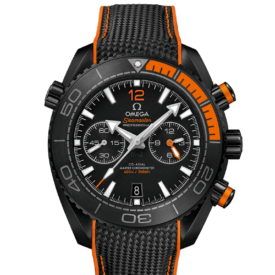Planet Ocean: The Root's of Omega's Most Popular Dive Watch
Author: Alex Collins
Omega created the Planet Ocean to be a modern luxury dive watch that would compete with the “tried and true” comparable offerings like the Rolex Submariner. It’s also worth noting that the Seamaster line overall has always been intended as more of a luxury piece in the body of a solid tool watch rather than a tool watch that eventually found its way on the wrists of well-heeled watch lovers.
One point of note, I am going to keep this list to non-precious metal models and will also not go through the history of the Planet Ocean chronograph because that discussion, or any discussion of a non-Speedmaster chronograph from Omega would require a thorough side by side look with the various Speedmaster references being made at any given point, and that is a very long conversation for another day. That being said, all the core references, along with the GMT models, and ultra-modern innovations like the Deep Black, will all be accounted for.
The Planet Ocean was the first diver Omega outfitted with their calibre 2500 movement that featured a co-axial escapement, and it came in three variations when it was launched, which is hilarious compared to the 27 models and 109 variations I see in the catalog now, some thirteen years later in 2018. The first Planet Oceans came in either 42mm or 45.5mm, with a black or orange bezel. The color orange is the unofficial color of the Planet Ocean line, claimed to be one of the most visible colors underwater (a claim I have heard refuted a few times, actually), but I have a feeling the aesthetic stamp was alluring to Omega as well.
1ST GENERATION OMEGA SEAMASTER PLANET OCEAN DESIGN
The model that initially inspired the first Omega Seamaster Planet Ocean collection back in 2005 was the Seamaster 300 ref. 165.024, which dated back to the 1960s. This can be a little counterintuitive when understanding the history of the Planet Ocean since they released a true to the original modern watch in the Seamaster 300 Master Co-Axial back in 2014. While nothing close to a vintage reissue, the first generation of Planet Ocean watches clearly wears this design influence on its sleeve. Or rather, on the design of its bezel, hands, and dial. The Planet Ocean asserted its own style, however, with an aggressively sporty look and touches like a helium escape valve. Later Planet Ocean generations would move on with the times in terms of material and style, securing the collection’s place as a luxury dive watch that is very much “of the moment” and isn’t afraid to evolve.
The first generation of Planet Ocean watches featured the aluminum bezel, about 1/3 of which was the untreated inner ring with the outer 2/3 being done in either black or orange. The 120-click coin edged unidirectional bezel is one of the aesthetic markers and tactile standouts of the Planet Ocean line, joined with the signature helium escape valve at 10 o’clock which has carried through into every Planet Ocean watch. It’s a somewhat vestigial addition that can be about as divisive a feature as date windows, and personally I would probably like the option to not have a helium escape valve.
The matte black lacquered dial along with the faceted arrowhead hour and minute hands (with Super-LumiNova) make for a highly legible and attractive dial across the range. I love the Arabic numerals at 6, 9, and 12 o’clock and the date window is about as least intrusive as it can be, since the background of the window matches the dial and there’s no magnifying lens over it. The simple, attractive design coupled with luxury finishes (that have been updated and upgraded with time, as this article will lay out) has been a cornerstone towards the success of the Planet Ocean.
1ST GENERATION OMEGA SEAMASTER PLANET OCEAN CASE
Being a top-tier Omega dive watch, the Planet Ocean watches are all water-resistant to 600m (2,000 feet) – double the resistance of the Seamaster Professional of the time. Earlier models like these first generation watches have a steel caseback with the engraved Omega Seamaster logo featuring the recognizable seahorse, aka Hippocampus. Interestingly and of note, Omega claims that with the Helium escape valve unscrewed the watch is still decently water-resistant to 50m. I assume this is relevant if only to ease the minds of forgetful owners who like to play with their watches.
One final thing to mention about all Planet Ocean watches, old and new. These have always been thick watches, with some recent chronograph versions reaching a downright fat measurement of 18.87mm thick. The 42mm version of the first generation Planet Ocean doesn’t approach this level of thickness at 14.5mm thick, but the 45.5mm model is a hefty 17mm thick. To compare, a 41mm wide Seamaster Professional at the time would have been about 12mm thick.
What’s always been impressive about the Planet Ocean is the fact that though it features a domed sapphire crystal, it has always remained highly legible due to the smart decision to use ample anti-reflective coating. More than one Planet Ocean owner I’ve talked to has pointed out how great the AR is, and I’d absolutely agree with them as I’ve always been impressed with the clarity on the dial of my own PO.
THE CALIBRE 2500 CO-AXIAL MOVEMENT
There was nothing completely new about the calibre 2500 movement when the Planet Ocean launched in 2005, though the movement had slowly been refined since 1999 when Omega purchased the co-axial technology from the legendary George Daniels.
The 48-hour power reserve calibre 2500 has been updated several times since it was released in 1999 (Rob Caplan of Topper got into the history here), and the first generation Planet Ocean was outfitted with the third iteration of the movement or the “C version.” The A version from 1999 was based on the earlier calibre 1200, which was based on an ETA 2892-A2 movement. The B version came soon after in 2000 and included an updated and more resilient palette bridge. Rob explains “The primary difference between B and C is that the C slowed down the movement from 28,800 vph to 25,200 vph. With the modern version of the 2500 calibre, the main feature benefit over a 1200 calibre is that it boasts a service interval around double that of its Swiss lever escapement predecessor.”
1ST GENERATION OMEGA SEAMASTER PLANET OCEAN VALUE
The larger 45.5mm versions (black bezel ref. 2200.50.00 and orange bezel ref. 2208.50.00) differed from the 42mm models in that they were significantly thicker at about 17mm thick and had wider 22mm lugs a watch that size would suitably need. In terms of value there was never really a market preference that made one model into a “collector’s item” more than the other, as examples of either trade for between $3,100-$4,500 depending on condition and whether the watch in question comes with the box or papers. When new, a ref. 2900.50.91 (black bezel on rubber strap) retailed for $4,400.
While I can’t find reliable information to confirm an at-the-time MSRP for the 45.5mm PO, I do know that a ref. 2201.50 (black bezel on bracelet) retailed for $3,400 USD in 2006. Seamasters have a bit of a reputation for taking big knocks on resale value, but I’m seeing a few of these references for sale (with box and papers) between $3,100-$3,500. Of course, adjusting for inflation, the price of $3,400 in 2005/2006 would be closer to $4,300 in 2018.
Long story short, any generation of the Omega Seamaster Planet Ocean shouldn’t be seen as an investment. It’s a mass produced luxury product that Omega has no problem constantly updating and changing. Buy it because you love it.
ENTER JAMES BOND 007
The Omega Seamaster Planet Ocean connection with James Bond is indelible at this point, and naturally, the Planet Ocean found its way onto Daniel Craig’s wrist in 2006. As I mentioned in the introduction to this article, Bond had been wearing an Omega Seamaster since 1995’s Goldeneye but had opted for a Seamaster Professional 300M for nearly a decade.
Alex Collins is the founder of Jeweler Social, a digital marketing agency for jewelry retailers, brands, and vendors. We've worked with the top names in the industry, and develop websites, marketing strategy, content development, SEO, PPC management, and App development. You can visit their website at jewelersocial.com

